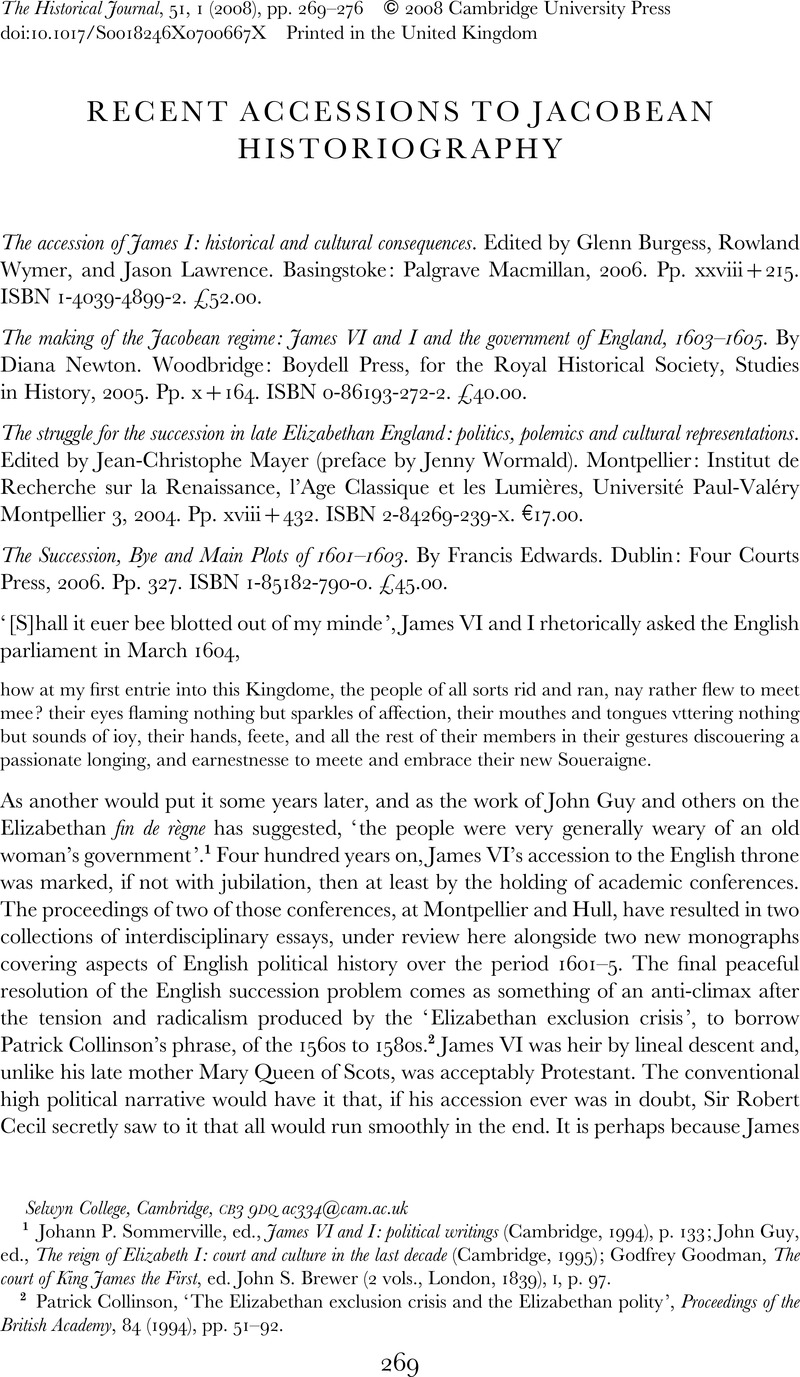No CrossRef data available.
Published online by Cambridge University Press: 25 March 2008

1 Johann P. Sommerville, ed., James VI and I: political writings (Cambridge, 1994), p. 133; John Guy, ed., The reign of Elizabeth I: court and culture in the last decade (Cambridge, 1995); Godfrey Goodman, The court of King James the First, ed. John S. Brewer (2 vols., London, 1839), i, p. 97.
2 Patrick Collinson, ‘The Elizabethan exclusion crisis and the Elizabethan polity’, Proceedings of the British Academy, 84 (1994), pp. 51–92.
3 See, for example, Pollen, J. H., ‘The question of Queen Elizabeth's successor’, The Month, 101 (1903), pp. 517–32Google Scholar; idem, ‘The accession of King James I’, The Month, 101 (1903), pp. 572–85Google Scholar; idem, ‘Religious terrorism under Queen Elizabeth’, The Month, 105 (1905), pp. 271–87Google Scholar.
4 Samuel Rawson Gardiner, History of England from the accession of James I to the outbreak of the Civil War, 1603–1642 (new edn in 10 vols., London, 1895), i, pp. 117–18 n. 3.
5 Mark Nicholls, Investigating Gunpowder Plot (Manchester, 1991); idem, ‘Treason's reward: the punishment of conspirators in the Bye Plot of 1603’, Historical Journal, 38 (1995), pp. 821–42CrossRefGoogle Scholar; idem, ‘Two Winchester trials: the prosecution of Henry, Lord Cobham, and Thomas, Lord Grey of Wilton, 1603’, Historical Research, 68 (1995), pp. 26–48CrossRefGoogle Scholar; idem, ‘Sir Walter Ralegh's treason: a prosecution document’, English Historical Review, 110 (1995), pp. 902–24Google Scholar.
6 The National Archives, SP 14/1/16, fo. 30r (Sir Robert Cecil and Edward Bruce to Lord Henry Howard, 9 Apr. 1603).
7 Marie Axton, The queen's two bodies: drama and the Elizabethan succession (London, 1977); Collinson, Patrick, ‘The monarchical republic of Queen Elizabeth I’, Bulletin of the John Rylands Library, 69 (1987), pp. 394–424CrossRefGoogle Scholar.
8 Lori Anne Ferrell, Government by polemic: James I, the king's preachers, and the rhetorics of conformity, 1603–1625 (Stanford, CA, 1998); Peter E. McCullough, Sermons at court: politics and religion in Elizabethan and Jacobean preaching (Cambridge, 1998).
9 John Guy, ‘Introduction: the 1590s: the second reign of Elizabeth I?’, in Guy, ed., The reign of Elizabeth, pp. 13–15; John Guy, ‘Tudor monarchy and its critiques’, in John Guy, ed., The Tudor monarchy (London, 1997), p. 100.
10 Susan Doran, ‘Loving and affectionate cousins? The relationship between Elizabeth I and James VI of Scotland, 1586–1603’, in Susan Doran and Glenn Richardson, eds., Tudor England and its neighbours (Basingstoke, 2005), pp. 203–34. On James's Trew Law as a polemical response to Persons's succession tract, rather than primarily a belated reply to George Buchanan, see also Lake, Peter, ‘The king (the queen) and the Jesuit: James Stewart's True law of free monarchies in context/s’, Transactions of the Royal Historical Society, 6th series, 14 (2004), pp. 243–60Google Scholar.
11 MacDonald, Alan, ‘James VI and I, the Church of Scotland, and British ecclesiastical convergence’, Historical Journal, 48 (2005), pp. 885–903CrossRefGoogle Scholar, at pp. 891–3, 897.
12 Sommerville, ed., Political writings, pp. 19–20 (Basilicon Doron) and 230, 232 (Meditation upon the 27th, 28th and 29th Verses of the 27th Chapter of Saint Matthew).
13 Goodare, J., ‘The Scottish parliament of 1621’, Historical Journal, 28 (1995), pp. 29–51CrossRefGoogle Scholar; MacDonald, ‘British ecclesiastical convergence’. See also P. Croft, King James (Basingstoke, 2003), pp. 186–7.
14 For a fuller discussion of the discourse of favouritism, see Curtis Perry, Literature and favoritism in early modern England (Cambridge, 2006).